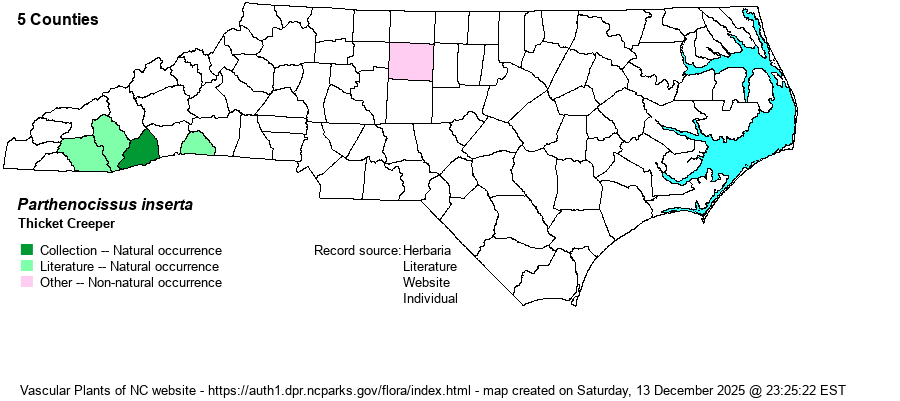| Author | (Kerner) Fritsch | |
| Distribution | The SERNEC website shows a 2006 specimen record for Transylvania County (in the southern Mountains). Recently (2010) found in Polk County, in the extreme southwestern Piedmont. These are major range disjunctions to the south and east of the main range. In 2023, Weakley submitted a photo on iNaturalist, at a site in Macon County; as this county lies between Transylvania County and the primary part of the native range to the west of the state, the editors have added to record to the map below. A photo on iNaturalist from Jackson County appears to be correct, as do a few others from southern tier counties in the Mountains.
This is a northern and western species, found mainly south to PA and WV as certainly native, but of uncertain provenance south to e. VA, w. NC, and TN. The NC observer/collector believes the population in Polk County is of natural occurrence, and if so, then populations in the southern Mountains of NC are also likely correct.
| |
| Abundance | Poorly known, but likely extremely rare, It is considered as State Significantly Rare. Provenance of a few records is open to question, but most records appear to be from "natural" sites in rich forests, away from civilization. | |
| Habitat | The Polk County site is a rich, high pH bottomland forest. In its normal range, it favors moist or rich bottomland forests and thickets. | |
| Phenology | Blooms and fruits in June and July. | |
| Identification | This is a high-climbing woody vine, with deciduous leaves very much like those of the very common P. quinquefolia. The five leaflets tend to be shiny above (and thus making the leaflets look a bit thicker or more evergreen-looking); Virginia Creeper has leaves with little or no gloss above. The leaflets also tend to be a darker green and wider and more strongly toothed than the slightly narrower leaflets of P. quinquefolia. The inflorescence of this species does not have a distinct main axis, and as a result the axis branches into several nearly equal branches, and these into other nearly equal smaller branches. The result is that the inflorescence of this species is corymbiform (flattened to gently rounded), often wider than long; Virginia Creeper has a panicle of flowers and fruit that is longer than wide. As this species is only known from one site in the state, and Virginia Creeper is so common, it is highly likely that most people would overlook this rare species; thus, calling a Parthenocissus as a Virginia Creeper in NC is almost always justified. | |
| Taxonomic Comments | Some references name this species as P. vitacea. Perhaps as many or more references have named the species as P. inserta – including Weakley (2018). Old references had the species in another genus, as Cissus verticillata.
| |
| Other Common Name(s) | False Virginia Creeper, Woodbine, Grape Woodbine, Hiedra Creeper | |
| State Rank | S1 | |
| Global Rank | G5 | |
| State Status | SR-P | |
| US Status | | |
| USACE-agcp | | |
| USACE-emp | | |

